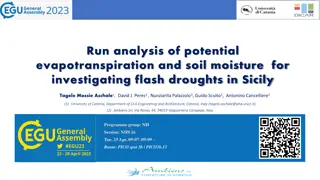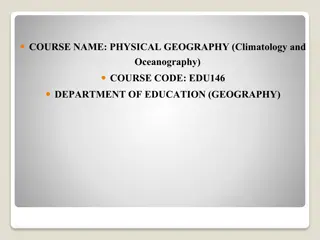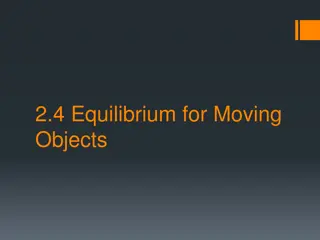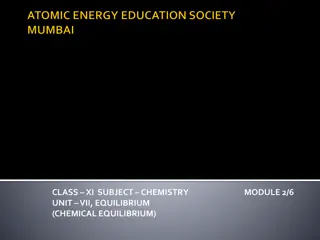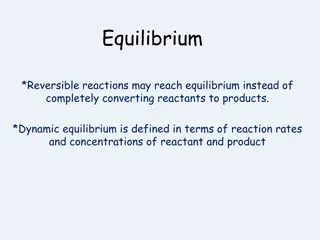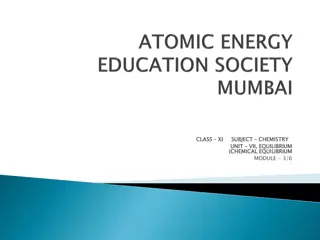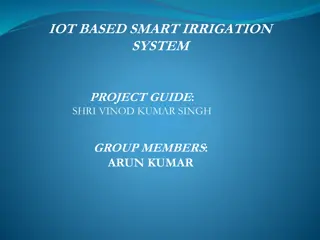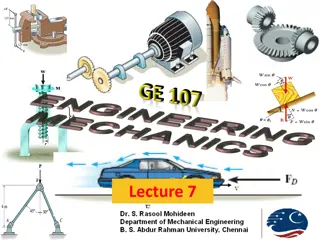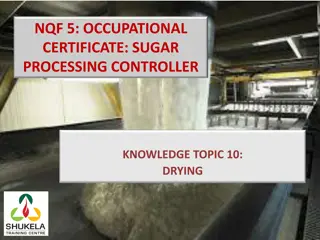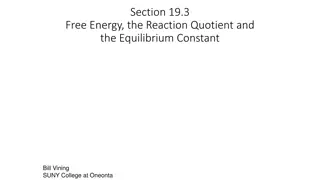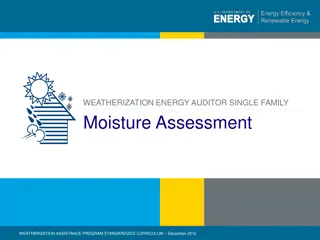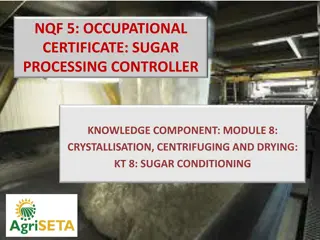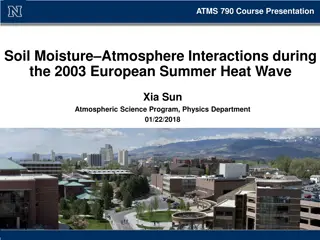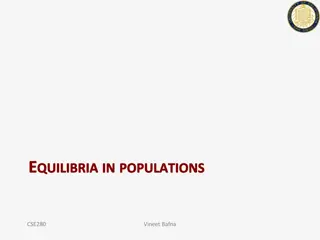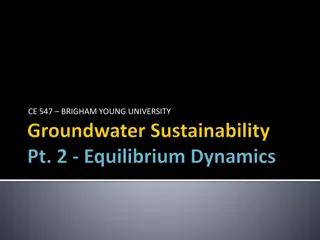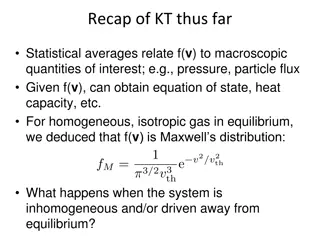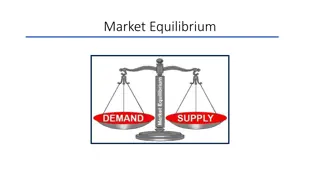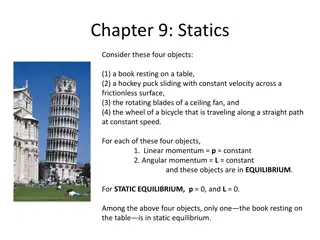Evaluation of SPLASH and HRRR Soil Moisture Comparison
This study compares soil moisture data between the HRRR model and SPLASH observations during the 2022 warm season. It explores differences in soil moisture levels at various depths, evaluates responses to precipitation events, and drydown periods. The research focuses on analyzed data from HRRR Mode
7 views • 12 slides
Investigating Flash Droughts in Sicily Using Evapotranspiration and Soil Moisture Analysis
This study focuses on identifying flash droughts in Sicily by analyzing potential evapotranspiration and soil moisture anomalies. The research examines trends in evapotranspiration and soil moisture levels over the past 22 years, pinpointing a possible flash drought occurrence in eastern Sicily in 2
5 views • 29 slides
Atmospheric Moisture in Physical Geography
Atmospheric moisture, in the form of water vapor, liquid water, and ice, plays a crucial role in shaping weather and climate. This course delves into the dynamics of atmospheric moisture, including its distribution, effects on weather patterns, and impact on various climatic factors such as precipit
1 views • 7 slides
Equilibrium for Moving Objects
Objects can be in static equilibrium when at rest or dynamic equilibrium when moving at a constant speed. Equilibrium is maintained when there is no net force to change the state of motion. This equilibrium is possible when forces either cancel out or there is no force acting on the object. Friction
3 views • 8 slides
Chemical Equilibrium in Reversible Reactions and Laws
Chemical equilibrium in reversible reactions involves the balance between forward and backward reactions, as governed by laws like the law of mass action and the law of chemical equilibrium. These laws help in understanding the rates of reactions, equilibrium constants, and the relationship between
3 views • 12 slides
Dynamic Equilibrium in Chemical Reactions
Explanation of reversible reactions, dynamic equilibrium, and the characteristics of equilibrium in chemical systems. Covers the concept of reversible reactions, dynamic equilibrium, rules for dynamic equilibrium, and examples to illustrate these concepts visually.
2 views • 54 slides
Le Chatelier's Principle in Chemical Equilibrium
Le Chatelier's Principle states that when a system at equilibrium is disturbed by changes in concentration, temperature, or pressure, the equilibrium shifts to counteract the change. This principle can be applied to predict the direction of equilibrium when changes occur. Changes in concentration, p
1 views • 10 slides
IoT Based Smart Irrigation System Project Guide
Monsoon-dependent Indian agriculture can benefit from an automatic irrigation system that prevents both over- and under-irrigation. By leveraging wireless technology, such as sensors for soil moisture, air humidity, temperature, and water levels, this project aims to optimize crop production by savi
28 views • 14 slides
Equilibrium of Rigid Bodies: Moments, Couples, and Forces
The topic covers the equilibrium of rigid bodies with a focus on moments, couples, and forces. It discusses concepts such as moments of a force, Varignon's theorem, types of supports, and equilibrium in two and three dimensions. The equilibrium in two-force members and three-force members is explain
2 views • 23 slides
Moisture Measurement in Sugar Processing
This content delves into the importance of moisture measurement in sugar processing, specifically focusing on the drying process. It explains how moisture percentage is crucial for various calculations and efficiency assessments in the sugar production industry. The equipment and procedures used for
6 views • 12 slides
Consumer Equilibrium in Economics
Consumer equilibrium refers to the point where a consumer maximizes satisfaction by spending income on commodities. In single commodity case, equilibrium is achieved when marginal utility equals price. For two commodities, equilibrium is reached when the ratio of marginal utility to price is equal.
5 views • 7 slides
Free Energy, Reaction Quotient, and Equilibrium Constant
This educational material delves into the concepts of free energy, reaction quotients, and equilibrium constants in chemical systems. It explains how to determine the direction of a reaction based on Q and K values, elucidates the role of Gibbs free energy in determining spontaneity, and provides ca
3 views • 10 slides
Chemical Equilibrium in Reversible Reactions
Chemical equilibrium occurs when the concentrations of reactants and products remain constant over time in a reversible reaction. Reaction rate is proportional to concentration, and equilibrium is reached when the rate of formation equals the rate of consumption in both directions. Reversible reacti
2 views • 25 slides
Soil Moisture Retrieval Over Bare Surfaces Using Radar Observations
This study focuses on retrieving soil moisture over bare surfaces using radar observations and a lookup table representation of forward scattering. The research aims to develop a non-empirical and simple method for accurate soil moisture retrieval without the need for ancillary information. Issues w
6 views • 14 slides
Advances in Remote Sensing for Soil Moisture Validation and Calibration
Cutting-edge methods like Cosmic-Ray Neutron Sensing (CRNS) and mobile measurements are revolutionizing soil moisture validation and calibration. From satellite-based techniques to local approaches, researchers are enhancing the accuracy and reliability of soil moisture data for various applications
2 views • 15 slides
Wireless Soil Moisture Tension Measurements for Irrigation Management
High-density, multiple-depth wireless soil moisture tension measurements were conducted in a vineyard in Napa Valley. The study found correlations between soil moisture tensions and leaf water potential, offering valuable insights for irrigation management. Utilizing a wireless sensor network, the s
3 views • 16 slides
Moisture Assessment in Weatherization Energy Auditing for Single Family Homes
This December 2012 curriculum focuses on moisture assessment in the weatherization energy auditing process for single-family homes. It covers analyzing symptoms of moisture problems, identifying sources, understanding moisture control strategies, and using assessment tools. The training aims to equi
5 views • 26 slides
Climate Models and Moisture Equilibrium in Flexible Pavement Design
Climate inputs like temperature and moisture play key roles in flexible pavement design. The heat transfer model evaluates frost action and temperature regimes, while moisture equilibrium models consider the interaction between soil suction and moisture content. Understanding these factors is crucia
6 views • 13 slides
Sugar Processing Controller Knowledge: Conditioning and Moisture Control
Understanding the importance of sugar conditioning in preventing caking during transport and storage. Factors affecting sugar conditioning efficiency include temperature, air flow, crystal size, feed sugar moisture, and more. Learn about the techniques and processes involved in sugar conditioning to
9 views • 7 slides
Evaluation of Soil Moisture Estimates from Satellite-Based Products
The study evaluates soil moisture estimates from satellite-based products over two network regions. Soil moisture is crucial for the hydrological cycle, necessitating continuous monitoring due to its spatial and temporal variability. Remote sensing is utilized to gather information without physical
4 views • 5 slides
Soil Moisture-Atmosphere Interactions in the 2003 European Summer Heat Wave
This presentation discusses the significant impacts of soil moisture-atmosphere interactions during the 2003 European Summer Heat Wave, highlighting the abnormally hot weather, pavement buckling, and high-pressure systems that contributed to the extreme conditions. The images and diagrams illustrate
3 views • 27 slides
Insights into Persuasion and Equilibrium in Multidimensional Cheap Talk
Explore the dynamics of multidimensional cheap talk, focusing on sender-receiver interactions, influential equilibrium, welfare rankings, and fragility to asymmetries. Lessons touch on bubbling equilibrium, influential equilibrium issues, welfare rankings preferences, and the impact of asymmetric pr
3 views • 20 slides
Equilibria in Populations: Hardy-Weinberg Principle
Exploring the concept of equilibria in populations, focusing on Hardy-Weinberg principles and its implications. The discussion covers allele distributions, genotype frequencies, maintenance of equilibrium across generations, and scenarios where equilibrium may be violated. Key points include basic p
0 views • 58 slides
Groundwater Sustainability and Equilibrium Dynamics
This content delves into the concepts of groundwater sustainability, equilibrium, and capture in relation to groundwater management. It explores transitional storage, groundwater mining, and debunks the water budget myth. The images and explanations illustrate how pumping affects aquifers, the evolu
1 views • 11 slides
Insights into Particle Ratios and Equilibrium Dynamics at LHC
Collection of observations from LHC data regarding particle ratios and the successful Thermal Model. Discusses the concept of equilibrium, onset of equilibrium, relationship to QGP phase, and potential solutions through out-of-equilibrium studies. Also delves into size/volume dependence, strangeness
2 views • 11 slides
Insights into Non-equilibrium Kinetic Theory: Inhomogeneous Systems
Statistical averages in kinetic theory connect distribution functions to macroscopic properties like pressure and particle flux. When systems are inhomogeneous or away from equilibrium, local equilibrium breaks down, leading to slow relaxation processes towards global equilibrium. The evolution of p
5 views • 12 slides
Equilibriums in Physics
Equilibrium in physics refers to the state of a body where there is no change in translational or rotational motion. This state can be classified into static equilibrium (when total force and torque are zero) and dynamic equilibrium (when a body is in uniform motion with zero resultant force and tor
5 views • 9 slides
Market Equilibrium
Market equilibrium is achieved when the quantity demanded equals the quantity supplied at a specific price, ensuring a balance in the marketplace. Demand and supply schedules play a crucial role in determining market equilibrium, with excess supply or demand occurring when prices deviate from the eq
3 views • 12 slides
Game Abstraction and Equilibrium
Extensive-Form Game Abstraction with Bounds delves into the complexities of game abstraction, exploring theoretical guarantees, algorithmic challenges, and equilibrium-finding processes. The difficulty of game abstraction is examined, highlighting issues such as pathologies and the struggle to optim
5 views • 22 slides
Chemical Equilibrium in Chemistry
Exploring the concept of chemical equilibrium in chemistry, where reactions can occur in both forward and reverse directions to an appreciable extent. Learn about basic equilibrium principles, equilibrium problems, manipulating reactions, and common example problems in nomenclature. Understand how r
2 views • 24 slides
Modeling of Transformer Vacuum Drying Process and Mathematical Analysis
This research paper focuses on modeling the transformer vacuum drying process for removing moisture from main insulation materials to enhance dielectric strength. Mathematical models and simulations are utilized to predict moisture content, optimize process parameters, and analyze the drying process
0 views • 14 slides
Dynamics of Machines - Static Force Analysis and Equilibrium Principles
This content covers Static Force Analysis in Dynamics of Machines, focusing on static equilibrium, equilibrium of two and three-force members, and solving equilibrium problems. It explains the conditions for static equilibrium, concepts of force analysis, and practical applications.
2 views • 21 slides
Equilibrium Conditions and Applications in Physics
Learn about static equilibrium, equilibrium requirements, equations for equilibrium, and how to apply equilibrium conditions to rigid bodies in physics. Explore examples and problems related to static equilibrium and forces in various objects.
17 views • 9 slides
Chemical Equilibrium Concepts & Equilibrium Constants
This content delves into chemical equilibrium, examining the concept, graphical representation, equilibrium constant expression, and examples related to equilibrium constants like Kc and Kp. It also covers mass action rules governing forward and reverse directions. The relationship between Kp and Kc
3 views • 43 slides
Climate and Moisture Considerations in Flexible Pavement Design
Understanding the impact of climate and moisture on pavement design is crucial. This article discusses the significance of temperature and moisture in pavement design, along with models to analyze heat transfer and moisture equilibrium. Key concepts such as the modulus dependency on temperature, hea
0 views • 13 slides
Understanding Chemical Equilibrium and Dynamic Equilibrium
Explore the concept of chemical equilibrium, the significance of the double arrow in reactions, characteristics of reaction mixtures in equilibrium, and more. Learn about homogeneous and heterogeneous equilibria and how to write chemical equilibrium expressions for different systems.
2 views • 14 slides
Understanding Static Equilibrium Conditions in Physics
Explore the concept of static equilibrium in physics, discussing conditions for equilibrium and the importance of balancing forces and torques to maintain stability. Learn about translational equilibrium and rotational equilibrium, along with practical examples illustrating these principles.
0 views • 24 slides
Moisture Expansion Coefficients of Glass/Epoxy Lamina Analysis
Explore the micromechanical analysis of moisture expansion coefficients for a Glass/Epoxy lamina with 70% fiber volume fraction. Calculate the coefficients using the properties of glass and epoxy materials. Gain insights into the calculation process and understand the significance of moisture expans
0 views • 8 slides
Understanding the Concept of Equilibrium in Chemistry
Explore the concept of equilibrium in chemistry through a series of images and explanations covering topics such as dynamic equilibrium, phase equilibrium, solution equilibrium, reversible reactions, and more. Enhance your understanding of chemical equilibrium and its importance in various processes
0 views • 23 slides
Mastering Equilibrium Concepts and Examples: CHE 112 Spring 2021 Lecture 13a
Explore the fundamentals of equilibrium, including its definition, examples, connection with thermodynamics, equilibrium constants, key phenomena, and mathematical aspects. Dive into past examples like phase changes, dynamic equilibrium, solubility, and thermodynamics equilibrium to enhance your und
1 views • 14 slides

